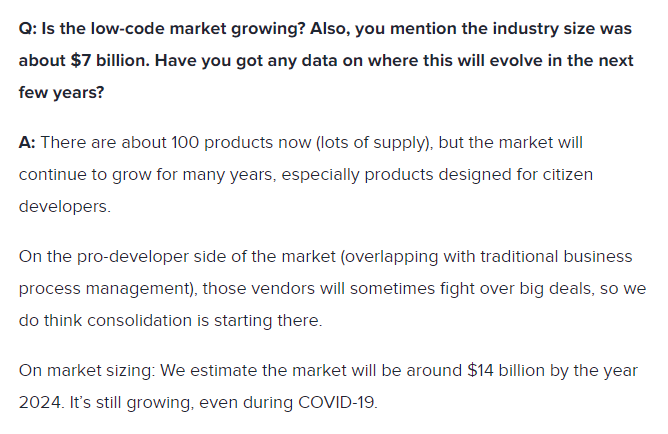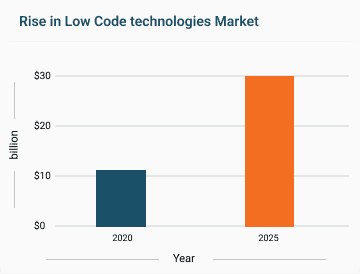Low Code/ No Code Development Platforms began to compete with off-the-shelf software and custom app development in 2011. According to Forrester, the low-code market will grow from $7 billion to $14 billion by 2024. Although low-code development cannot completely replace hand-coding, there are many instances where low-code software’s functionality is sufficient.
The project management lesson learned: what do they entail?

With the expanding number of Low Code/ No Code Platforms available, any business user with no technical or design expertise may create a user interface for their app, digitize company processes, streamline inventory management, and more. There is a slew of Low Code/ No Code applications.
But what are these Low Code/ No Code Solutions exactly?
Low Code/ No Code Development Platforms are visual software development frameworks that let enterprise and citizen developers drag and drop application components, connect them, and build mobile or web apps. It helps the organizations to accelerate their digital transformations.
A low-code platform is an application development platform that enables you to construct business and mobile apps without code. Instead of writing long lines of code, they employ a graphical user interface with minimum logic and drag-and-drop capabilities.
On the other hand, no-code development platforms allow you to construct apps without writing a single line of code. It means that even if you don’t know how to code, you can create applications without difficulty.
According to a Forrester report, the market for Low Code Automation will grow to more than $21 billion in the next five years. Now, let us check a few Best Low Code/ No Code Platforms for small and medium businesses emerging in 2022.
7 Low Code No Code Automation Tools to Look For in 2022
#1 Mendix
With the help of Mendix, you can create apps that range from simple, time-saving utilities to enterprise-grade applications that help businesses run efficiently.
It’s a low-code platform that anyone can use to boost their business by providing high-quality apps without dealing with complicated coding. This app creation platform enables you to create impactful apps that can be deployed quickly and become profitable.
All you need is a great concept to get started with Mendix and construct your app. By simplifying and abstracting the development process, this all-in-one Low Code/ No Code App Development platform will assist you in producing higher-quality software.
#2 OutSystems
OutSystems is a sophisticated application development platform that equips enterprise developers with the tools they need to create and manage entire libraries of enterprise-class applications, rather than just simple departmental applications as most No Code Platforms do.
What makes OutStstems most favoured Low Code platform is it’s UI. Users can create apps by linking various components and have a visual feel of the logics that it uses. You can also use coding and save it as a component to use in later projects.
The community is very active and will help you find answers to most of your queries.
It includes visual development, the foundation of low-code development, and AI-assisted development, which guides developers through processes by proposing the next effective actions and help sources, reducing friction and lead times.
#3 Microsoft Power Apps
Microsoft’s Power Platform packs its Solutions as part of a business applications framework. Creating and sharing low-code applications is a breeze if you use Microsoft Power Apps. For Microsoft’s O365 current users it is very enticing to your business ecosystems. Using Power Apps and MS Flow you can integrate all your Microsoft apps to build a perfect workflow.
It enables you to quickly design apps that solve problems while improving procedures to boost business agility. They provide pre-built templates and a drag-and-drop tool to help you get started rapidly designing apps. As a result, you can go into deployment and make rapid improvements.
#4 Bryter
Are your services automated? When it comes to service automation you need to have look at BRYTER. It is simple, flexible and yet very powerful. BRYTER is a no-code platform that is loved my legal, compliance and other team due to its effective documentation automation.
It has a larger number of use case library to choose from various industries, teams and applications. You can choose the use case and modify it in very less time. The UI of the app is intuitive and makes creating apps fun and easy.
Integrations are great at increasing the power of BRYTER service. They can unlock several new use cases and enable you to take full advantage of your tech stack. You can integrate it in Salesforce, Microsoft SharePoint, MS Teams, Docusign, HighQ, iManage and so on.
#5 Zapier
Do you have multiple applications, and you find it difficult to connect them? Zapier is the answer. One of the most popular tools in the no-code automation that allows you to create workflow and has a huge template library to choose from.
Zapier helps you manage business needs through simple but powerful workflow automation, making it a fan favorite no-code app for everyone from solo freelancers to large Saas companies. But it has it’s own limitations.
#6 Appian
Appian, another popular Low Code/ No Code Development Platform, allows you to create robust and feature-rich applications with an interactive GUI. It organizes and automates your business processes and workflows straightforwardly.
They believe in making complex operations easier to understand and producing applications 10 times faster than before. Its clever and intelligent automation features, and its seamless integration, increase customer engagement and aid in creating unavoidable user experiences.
#7 NewGen
This platform frees up your IT personnel to focus on additional value-add duties develop end-to-end applications quickly with minimal coding. It helps automate your business processes, from simple departmental duties to sophisticated enterprise-wide operations to improve speed and agility.
Automate your business process with Ignatiuz:
According to Gartner, the low-code industry rose 23% in 2020 to $11.3 billion and is expected to expand to nearly $30 billion by 2025.

Low Code/ No Code Platforms are gaining popularity because they provide a simple and quick alternative to traditional development methods. As a result, both non-technical founders and professional developers turn to these platforms to suit their business needs for developing apps, automating processes, and accelerating digital transformation.
You can enhance operations and bring significant value to your organization by using IT services. Ignatiuz focuses on knowing your specific company requirements and recommending the best solutions to help you thrive and stand out from the crowd.
With Ignatiuz’s modernization solutions, you can make the most of your time, become more productive, and stay ahead of the competition. Visit https://stage.ignatiuz.com/ to get in touch with us.
